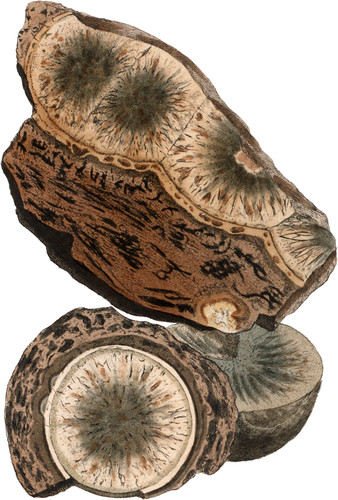 Enlarge
Enlarge
Exotic Mineralogy
Globular Feldspar
- Syn.
- Porphyre Napoléon. Rampasse.
- Feldspar Globeux. Lucas, pt. 2, 151.
- Roche porphyroïde globuleuse. Faugas de St. Font, Géologie, 2, 245.
- Porphyre globuleux, ib. 2, 683.
- Amygdaloïde porphyroïde. Brongniart Journal des Mines, 34, 41.
- Pyroméride globaire. Haüy, in a Memoir by Mr. Monteiro, Journal des Mines 35, 347 et 407.
- Globular Porphyry, vulg.
Mr. Rampasse, during a fruitless search after the original situation of the Orbicular Sienite, in the mountains of Corsica, about 1805, met, between Monte-Pertusato and the valley that leads to Santa Maria la Stella, with a block, resembling porphyry, but in place of crystals of Feldspar, it presented globose aggregations of that substance, composed of diverging bars, enclosed in a compact coat; the basis consisting of compact Feldspar, in small masses and grains, cemented together by a substance of a much darker colour, which seems to be a kind of impure Quartz, similar to the variety known by the name of Hornstone, and which often acts as the basis of true Porphyries. The Quartz also fills up the minute interstices between the bars of Feldspar in the balls. Some years afterwards Mr. Mathieu was so fortunate as to discover the same kind of rock in its original repository, in the form of large veins, projecting like immense walls from the mountains of true Porphyry, that they traversed, but which being of a looser, construction, had weathered away before thorn. The district in which these veins occur is hounded on ilic north by Marzolino, on the south by Bussaggia; it comprises the country of Ozani and also Girolata, an extent of ahout eight square miles and a half, composed of barren mountains. The halls are found in several places in abundance, separated from the rock as at Bocca-Vignolo and at Elbo. Much variety is observable in the colour and proportion of the parte of this curious rock; in some veins the halls are only a few lines in diameter; in others they are three or four inches: in some the basis is of a deep red, and the halls pale, with specks of red; in others the colour is more uniform, and the cement is in some abundant, in others hardly distinguishable. Besides the Feldspar and Quartz, this rock does not appear to contain any mineral except a few crystals of cubic oxide of Iron, of a dark colour, and brown oxide, which modifies the colour of the basis, and lenders the parts where it abounds more liable to disintegration. The Feldspar in no part exhibits the foliated structure of crystals, hut is every where compact and opaque, while the cement is in parts translucent, and, according to Monteiro, crystallised in some of the fissures. Respecting the origin of the rock little can he said with any degree of certainty; the arrangement of the parts seems to he the effect of a kind of imperfect crystallization, similar to what is produced frequently in Scoria and Glass, when kept some time in a certain temperature, and then cooled suddenly.* The infusible nature of the substance in which the Feldspar has shot, renders the idea of the igneous formation inapplicable; and obliges us to imagine some solvent of Silex, in which the Feldspar might crystallize. A similar observation will apply to many other rocks, whose formation is concealed hy that veil of mystery, through which we admire the works of Omnipotence, without being aide to discover the instruments they have been wrought by: an innate desire in man to remove this veil, is a source of industry, conducive to his happiness; and every advance he makes serves to expose the difficulty of the task, and hy displaying new wonders, increase his desire for knowledge, and enlarge his ideas of the incomprehensible Author of All.
- * The formation of globes of a radiated structure is, by Watts, Supposed to be the first step towards the formation of Basalt.

